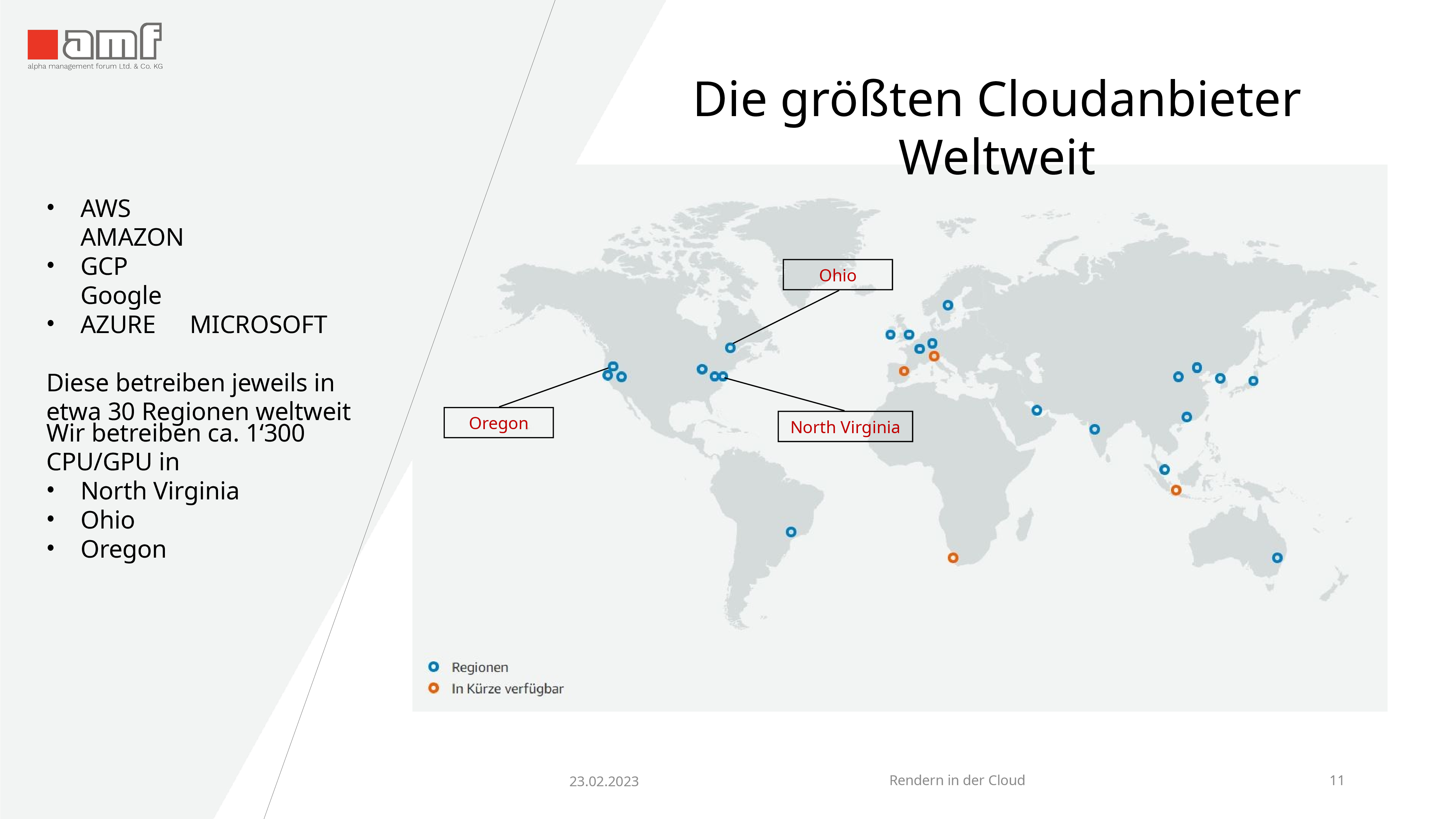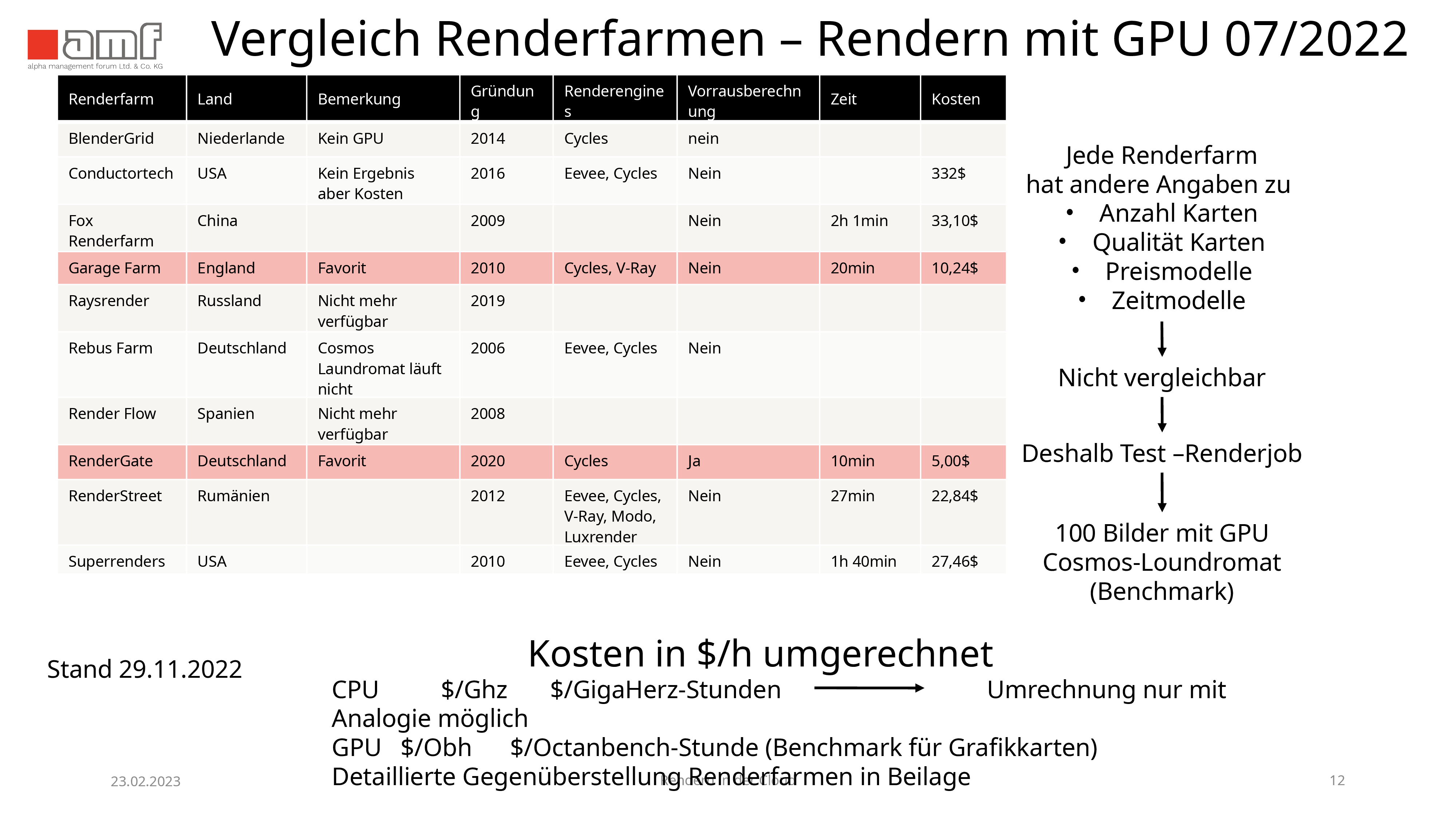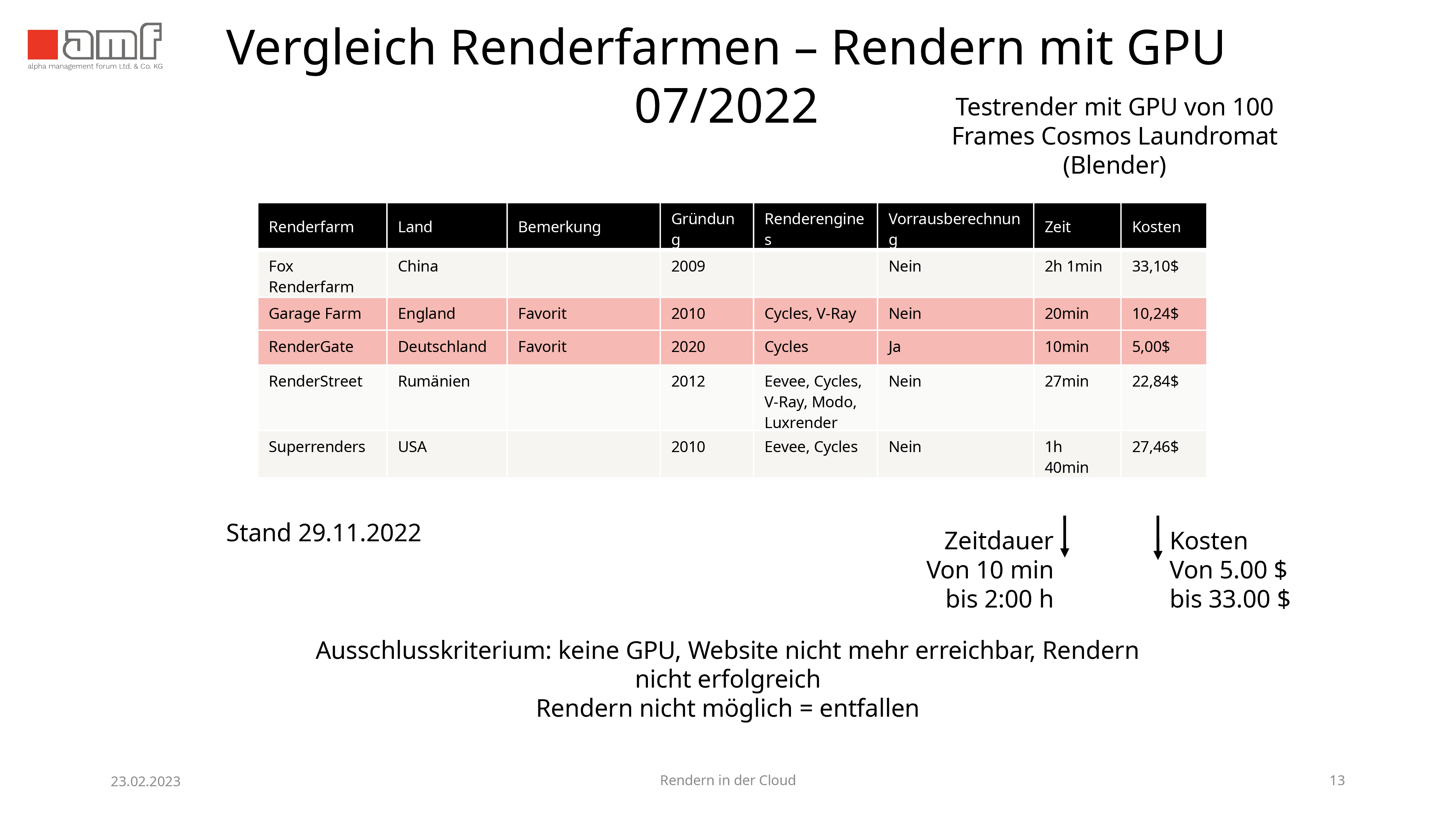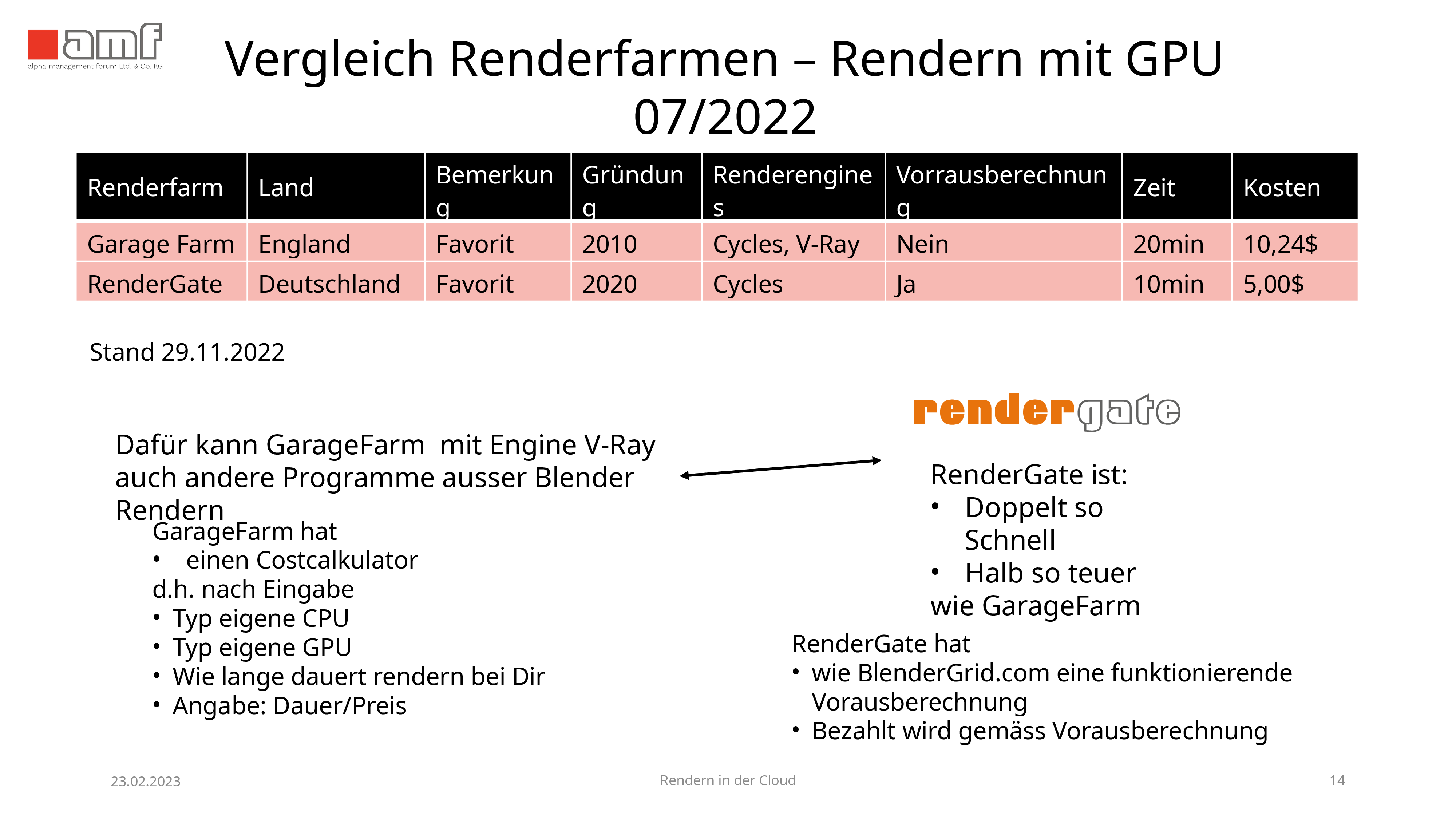What is Cloud Rendering (Long Version)
You can also read and watch this in: English Deutsch
The following article was created from the presentation Roy Ammerschuber gave on the 27.06.2023 at the Web Zurich.
Rendering 3D animation
Rendering is a normal production process for anyone who wants to generate images for video from 3D images/3D motion, and plenty of time needs to be allocated for it. For every second of video, you need 24 frames per second. These images have to be generated directly from the 3D program. That’s 4’320 frames for a 3 min video. If the rendering time per frame is for example 10 minutes, you need 30 days for rendering with your computer and a powerful graphics card (e.g. RTX 3080). Time that you usually don’t have to spare. This means that rendering is an extremely computationally intensive process.
Cloud solution
 (Figure 1)
(Figure 1)
The largest cloud providers are Amazon’s AWS, Google’s GCP, and Microsoft’s AZURE. These each maintain a worldwide network of about 30 regions (Figure 1, AWS), which in turn consist of about 3 data centers. In these data centers, one can rent storage space for a fee, but also virtual servers for computing processes. You can then run your computationally intensive processes there. The cloud provides both CPUs and GPUs with extremely different performance conditions. Thus, you can put together an optimal configuration for the current work task. For this purpose, there are instances with multiple CPUs and different numbers of cores and different capacities of RAM. The instances can also contain several graphics cards with different performance values. However, the respective cloud provides only the virtual server instances and you have to do the programming yourself for the calculation of images from the 3D program. The security of the data on the cloud is to be rated very high.
Render farms
Render farms are operated/offered by companies that render animations for a fee. The market of render farms is very extensive and also confusing. The render farms use either a very extensive inventory of their own servers or corresponding instances on the respective cloud for rendering. Which infrastructure is used by the render farms is not disclosed by every render farm.
Performance improvements with renderfarm
For the above example
- 3 min video, 4’320 frames, 10 min render per frame, graphics card GPU RTX 3080
you need 30 days on your home computer for rendering
Rendering on renderfarm:
- Same video, but 20 virtual graphics cards NVIDIA A10G (ca.equivalent to RTX3080)
you need only 1.5 days on the render farm. This performance is arbitrarily scalable/increasable on the cloud. - The costs for this are e.g. at RenderGate:
1.5 days x 24hx1,20 $/h x20 instances=864$Investigation render farms
 (Figure 2)
(Figure 2)
For this paper, we want to focus on render farms that allow rendering with GPUs. Because GPUs are fundamentally faster and more cost-effective. Nevertheless, the coverage of render farms must initially/initially be more inclusive. It is also irrelevant whether the render farm uses its own machine park or uses a cloud. So the entire market was researched and the following 10 render farms were crystallized: BlenderGrid, Conductortech, Fox Renderfarm, Garage Farm, Rays Render, RebusFarm, Render Flow, RenderGate, RenderStreet, Superrenders. These are based in very different countries. (Figure 2, compare all) They also all serve very different render engines that are necessary for different 3D programs. The information published in the websites about number of maps, quality of maps, price models, time models are extremely different and confusing. Furthermore, most render farms mix different units like $/Ghz ($ per gigaherz-hour) and $/Obh ($/Octanbench-hour) to name the price. This can be converted with very little accuracy and compares very poorly. Similarly, some render farms offer to price by some analogy, but this is also inaccurate. Therefore, we decided to perform a test rendering for all render farms.
Test-Rendering
 (Figure 3)
(Figure 3)
We tried to perform a test render on all of the above render farms. We used 100 images of the benchmark Cosmos Loundromat with a resolution of 1’920 x 1’080 pixels as test renderer. We then excluded all render farms where rendering was not possible or failed. In addition, we also excluded those whose website was no longer accessible or which do not provide a GPU. (Figure 3, Comparison Selected) For the remaining render farms, we found that the render time was between 10 minutes and 2 hours. The cost of rendering was between 5$ and 33$. The slowest render farm took up to 12 times the time of the fastest. The cost of the most expensive provider up to 6 times that of the least expensive.
Favorites Price/Performance
This leads us to our two favorites, which clearly stand out from the competition in both render time and cost.
These have a comparable price/performance ratio.
Summary of the comparison test
In this case RenderGate is twice as fast and half as expensive as GarageFarm.
RenderGate is more comfortable because it has a pre-calculation that can tell you how long it will take and how much it will cost before rendering. With RenderGate you are also charged according to the pre-calculation. By the way, apart from RenderGate, only BlenderGrid has a pre-calculation (eliminated because no GPU is offered, see Figure 2). With RenderGate, a precalculation can also be started without registration. However, GarageFarm can render other programs (e.g. 3Ds-max, Cinema 4D) in addition to Blender.
 (Bild 4)
(Bild 4)
RenderGate is the favorite for rendering with Blender. But GaragFarm is the favorite for rendering all other 3D animation programs (e.g. 3Ds-max, cinema 4D).
Possible switch to a render farm
It is certainly worthwhile to consider external rendering at an early stage, because with higher quality requirements and longer sequences, your own/local computing power will quickly no longer be sufficient and more powerful servers will then be needed for rendering. It is also to be expected (see Avatar) that the instances available on the cloud will get further performance increases faster, which is already becoming apparent now. The instances available on the cloud today were not available a year ago.
Before selecting a render farm for your project, you should proceed as follows:
- Prepare a certain number of images or a small animation, of which the duration for rendering on your own PC is known.
- Test on a selection of render farms whether the render job is executable there
The decision for a render farm should be based on ease of use, expected costs and render time.
Detailed comparison international render farms
The detailed comparison of render farms for CPU was completed 06/2020.
The detailed comparison of render farms for GPU was completed 06/2023.
You can download the detailed table with the analysis here.
Current trends in rendering processes using the film industry as an example
The possibilities offered by the use of 3D models/3D animation have improved by leaps and bounds in recent years. In a blockbuster, such as Avatar II The Way of Water (Figure 5), very detailed 3D models are created for people, animals, vehicles, water, trees, etc., which are set into appropriate motion.
![]() (Figure 5)
(Figure 5)
The film Avatar II, for example, was created and animated 95% in 3D. To render such an epic by James Cameron, the New Zealand company Weta FX had three Australian data centers from AWS, Amazon’s cloud provider, calculate over a longer period of time for rendering.
This enabled the film team to increase the frame rate from 24 frames per second to 48 frames per second. In addition, countless scenes could be rendered in hundreds of variations.
Weta FX:“……….To get the perfect shot, the company averages around 500 iterations per shot…………..Rendering each frame took he combined power of 3,000 vCPUs in the cloud for an hour……..“1
1,700 3D artists worked on the AVATAR project for 556 days each. During this time, the following objects were created: 3,750 digital 3D objects, 57 species (mythical creatures), 179 characters; blue-skinned inhabitants Na’vi, 230 novel plants. Production costs (excluding marketing) amounted to $0.50 billion. Revenues for the period from 12/2022 to 05/2023 totaled $2.30 billion.
